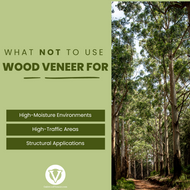Wood Veneer Sheet Limitations: What NOT to Use it for in Design
Jun 20th 2023
Wood Veneer Sheet Limitations: What NOT to Use it for in Design
Introduction: Wood veneer is a versatile material that has gained popularity in interior design projects. However, it's crucial to understand its limitations. In this article, we'll explore what not to use wood veneer for, focusing on outdoor environments, high-traffic areas, and structural applications.
Wood Veneer and Outdoor Environments
Wood veneer is unsuitable for outdoor environments due to its vulnerability to moisture, temperature changes, and UV exposure. Using wood veneer for garden furniture, decking, or exterior paneling can result in warping, cracking, and fading over time. Opt for materials specifically designed for outdoor use, such as solid wood, engineered wood, or weather-resistant synthetics like polyethylene.
Wood Veneer in High-Traffic Areas
Wood veneer is relatively delicate compared to solid wood, making it unsuitable for high-traffic areas like stairs and flooring. It lacks durability and impact resistance, making it prone to damage from frequent use and accidental impacts. Consider alternatives such as solid wood, laminates, or engineered wood with protective finishes that can withstand daily wear and tear without compromising aesthetics.
Wood Veneer in Structural Applications
Wood veneer is not suitable as a load-bearing material in structural applications. It lacks the necessary strength and structural integrity of solid wood. Using veneer instead of solid wood in beams, columns, or framing compromises the safety and stability of the structure. Consult with a structural engineer or professional to ensure appropriate load-bearing materials are used.
Understanding the limitations of wood veneer is crucial for making informed design decisions. Avoid using wood veneer in outdoor environments, high-traffic areas, and structural applications to prevent potential damage and safety concerns. Instead, choose materials specifically designed for the intended purpose. By selecting suitable alternatives like solid wood or engineered wood, you can achieve both aesthetic appeal and long-lasting results.
Want to learn more about wood veneer? Check out our tips and info page HERE.
